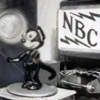Felix the Cat was a television and technology pioneer.
In 1928 RCA/NBC began testing their early television equipment with a Felix the Cat statue.
During the coming years, the Great Depression and World War II slowed the development of TV, but by the middle 1940s, TVs were ready to be sold commercially.
On November 7, 1946, a coin-operated television receiver was set up in New York City to introduce the public to TV. What do you think they saw on the screen in addition to test patterns? Yes, Felix the Cat was back.
Here is a video recreation of the 1928 RCA/NBC test:
“When serious interest in television in the U.S. began in the mid-1920s, a major challenge was to produce a transmitted image of decent quality. In order to improve the image transmitted, it was decided to use a small statue of Felix the Cat, a well-known animated character of the day. Felix’s image was to be transmitted from the television studio to serve as a test broadcast. Felix was just right for this purpose… the right color (black and white) and, as a statue, would be unaffected by the intense heat from studio lights.
The first image of Felix to be transmitted appeared as only 2 inches tall on the then-tiny television receiving screen. The image was broadcast for two hours a day, simply rotating on a turntable.”
“RCA’s first experimental television transmissions began in 1928 by station W2XBS (New York-Channel #1) in Van Cortlandt Park and then moved to the New Amsterdam Theater Building, transmitting 60 line pictures.
The 13″ Felix the Cat figure made of paper mache was placed on a record player turntable and was broadcast using a mechanical scanning disk to an electronic kinescope receiver.
The image received was only 2 inches tall, and the broadcasts lasted about 2 hours per day. By 1931 the station became part of NBC and began to transmit from 42nd St.”
During the 1920s -1940s Felix the Cat played an important role in testing and introducing television technology.
In the early 21st century, cat videos introduced millions of people to video on the Web. (Click here for a historic YouTube cat video.)
But the honor of the first cat video (or film) to help test and introduce a new technology may be Thomas Edison’s 1894 film classic, “The Boxing Cats.”






